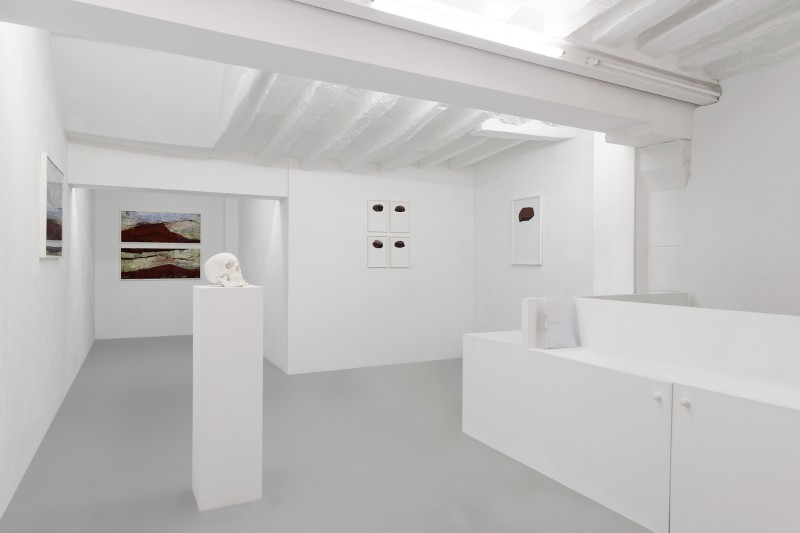
Opening on Saturday, October 15th 2016 from 5pm to 9pm
15.10 – 23.12.2016
_____________________
In 1917, Fernando Pessoa writes a rather strange initiatory tale, The Pilgrim, in which the narrator begins a trip inside his country, without really knowing the reason. Through cities and villages, he looks for a mysterious Man in black he had briefly seen. Beyond the roads of a single territory, Louis-Cyprien Rials starts from 2006 a stay of three years in Japan where he immortalizes neglected buildings. However posessed by geopolitics, he realizes he cannot content himself with a formal approach of these sites or making architectural poetics as his subject. In parallel, he develops a work on Italian stones, from the ones he collects, scans and builds some landscape picturality, then begins his videos. One of the first Nessuno – moreover the title of a Fernando Pessoa’s poem -, takes place inside the wind of a Spanish desert, evoking a Don Quijote facing his windmills … The tone hardens through the years, as the artist goes to Chernobyl, to the Turkish Republic Of Northern Cyprus, to Bahrain, then to Iraq in 2015, obsessed as much by the places than the people who haunt them, a subject he declines in his first gallery exhibition, Introducing.
A fantasized China, he was not able to visit after an accident in Kazakhstan, is the origin of some new works joining a perception of the country built through its clichés or realities. Carved stones, gathered on the Internet, allow one’s to have a doubt about the authenticity of their origin, but not on their appearance close to the materiality of the flesh. Sculptures in fake fordite, pleonasm of a mineral created by man and coming from paints of old car bodies, come along with a video that overplays, in kitsch tones, the impossibility of the tourists of Lexiaguo, a red ground of Dongchuan, not to saturate their colors. Until now, seduced by thoses complexions more associated with the idea of good taste, Louis-Cyprien Rials is keen on lively and dancing colors. Then, while grinding his teeth, he questioned the purpose of discovery thirst globe-trotters, combined with a real empathy for the inhabitants of the countries he visits, he publishes post cards of the places which are no more, such as the exclusion zone from Chernobyl, the city of Varosha, emptied after the Turkish invasion, or the former monument of the communist party in Bulgaria, Buzludzha, before imposing a rhythm break. Again, the elegance of the mineral printings which refer to the love, Pliny the Elder already had for stones. Just like Roger Caillois, who was interested in war and alongside noticed that paesinas, also called ruin marble, reproduced some of the landscapes evoking fired or ruined cities, full of minarets or belfries that were collapsing… Louis-Cyprien Rials witnessed massacred countries, specially when he goes to Bakofa in Iraq, and finds himself in a city left by Eastern Christians, whose ghosts only remain in their abandoned icons. He makes himself a Pilgrim and would have embodied a character from Pessoa. He fictionalizes his reality and takes action, which is considered more salutary than the suicidal rejection of the artist Bas Jan Ader, he often quotes.
We recognize his other references in his very strong tributes to Stalker, by Andreï Tarkovski and La Jetée, by Chris Marker, for his last videos, And there was no miraculous or Polygon. If this title obviously reminds the geometrical figure, it is also about an American website, dedicated to video games, which idea is to become attached to the story “behind” the game, as much as the very game. Sequenced in four parts, in black and white and color, his own Polygon refers in many levels to his two favorite film-makers. Louis-Cyprien Rials shares, with the Russian director, a mystic vision of the world and the will to impose, in his work, a not clarified border between imagination and reality. Also in his home, we search for a “Zone”, filmed by Tarkovski in front of the power plant of Tallinn, in Estonia, and lived here in the Nuclear polygon of Semipalatinsk. From La Jetée, we find the obsession of scars, war, death or cities destruction, that are made more bearable by the eroticism of the voices whispering in a foreign language. Even there, we speak about radioactivity and experience, like the one Louis-Cyprien Rials had for his first filmed performance. In And there was no miraculous, he immortalitzes himself naked and drying in the sun, after a dive in the Lake Chagan, created in 1965 in Kazakhstan by the eponym nuclear test. Beyond a sacrificial call or a search for stigmas, the experience confirms this desire for true moments, asserting that the artist does not lead a work on memory but on the constantly self feeding empirical exploration. However he does not cry, contrary to Bas Jan Ader who calls out the watcher of the infinite sadness of a video in which he he collapsed for lack of having nothing more to say.
In Stalker, the one we name the writer, reveals for a moment: “I dig the truth and meanwhile, something happens to it.”, and it is in this impulse that Louis-Cyprien Rials pursues his quest, pompously – but isn’t it the quality itself associated with this action ? – nevertheless specifying the coherence of his way through the projects he makes.
October 2016
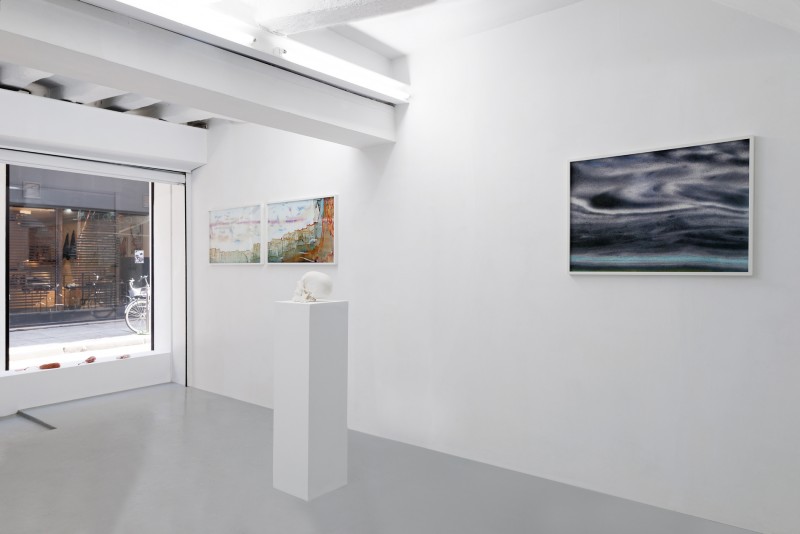
Louis-Cyprien Rials, Série Festin – Vaniteux, premier quart du XXIe siècle, 2016, 3D printing, ABS lament, variable dimensions, unique piece
Série Festin – Flesh stone, 2016,stone, colourants, red rope, variable dimensions, 3 unique pieces
Impressions minérales – Perspective 18, 2016, impression numérique jet d’encre sur papier Hahnemuhle 308 g, Dibond contrecollé sur aluminium, verre anti reflet, cadre érable laqué blanc, dyptique, 57 x 92 cm chaque, pièces uniques + 1 EA
Impressions minérales – Brume 14, 2016, ink jet digital printing on 308 g Hahnemuhle paper, glued sandwich pannel on aluminium, anti reflective glass, white laquered mapple wood frame, 67 x 92 cm, unique piece + 1 AP. Photo © Aurélien Mole

Louis-Cyprien Rials, Impressions minérales – Perspective 18, 2016, ink jet digital printing on 308 g Hahnemuhle paper, glued sandwich pannel on aluminium, anti reflective glass, white laquered mapple wood frame, diptych, 57 x 92 cm each, unique pieces + 1 AP

Louis-Cyprien Rials, Impressions minérales – Perspective 18, 2016, ink jet digital printing on 308 g Hahnemuhle paper, glued sandwich pannel on aluminium, anti reflective glass, white laquered mapple wood frame, diptych, 57 x 92 cm each, unique pieces + 1 AP

Louis-Cyprien Rials, Impressions minérales – Intermonde, 2016, ink jet digital printing on 308 g Hahnemuhle paper, glued sandwich pannel on aluminium, anti reflective glass, white laquered mapple wood frame, diptych, 48,5 x 112 cm each, unique pieces + 1 AP

Louis-Cyprien Rials, Impressions minérales – Intermonde, 2016, ink jet digital printing on 308 g Hahnemuhle paper, glued sandwich pannel on aluminium, anti reflective glass, white laquered mapple wood frame, diptych, 48,5 x 112 cm each, unique pieces + 1 AP
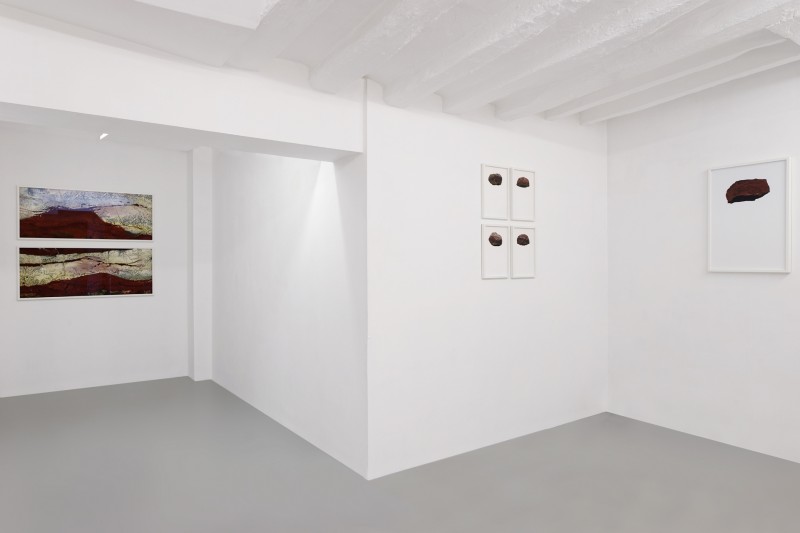
Louis-Cyprien Rials, Impressions minérales – Intermonde, 2016, ink jet digital printing on 308 g Hahnemuhle paper, glued sandwich pannel on aluminium, anti reflective glass, white laquered mapple wood frame, diptych, 48,5 x 112 cm each, unique pieces + 1 AP
Floating stones of the Turkish Republic of Nothern Cyprus, 2014, ink jet digital printing on 308 g Hahnemuhle paper, glued sandwich pannel on aluminium, anti re ective glass, white laquered mapple wood frame, 4 pieces, 36,5 x 25 cm each, edition of 5 + 2 AP
The floating rock of the Nuwaidrat roundabout – Bahrain, 2014, ink jet digital printing on 308 g Hahnemuhle paper, glued sandwich pannel on aluminium, anti re ective glass, white laquered mapple wood frame, 72 x 49 cm, edition of 5 + 2 AP. Photo © Aurélien Mole

Louis-Cyprien Rials, The floating rock of the Nuwaidrat roundabout – Bahrain, 2014, ink jet digital printing on 308 g Hahnemuhle paper, glued sandwich pannel on aluminium, anti re ective glass, white laquered mapple wood frame, 72 x 49 cm, edition of 5 + 2 AP

Louis-Cyprien Rials, Reliques (Iraq), 2016 – religious artefact found in Baqofah, nearby the Islamic State, Iraq 2015, anti reflective glass, white laquered mapple wood frame, 47,7 x 38 cm, unique piece
Voyage en Chine – Is French copy better than Chinese Original ? (vidéo), 2016, 4 K video, format 16 : 9, color, sound, 9’, edition of 5 + 2 AP
Honeycomb, 2016, stone and gold leaves, variable dimensions,
3 unique pieces
48 Posctards, 2016, 48 fictive postcards, paper, 10 x 15 cm each, metal showcase, variable dimensions, unique installation, serie of postcards
Adhan – Cartes postales, 2016, ancient postcards, paper, anti reflective glass, white laquered mapple wood frame, serie of 3, 41,5 x 32,3 cm, unique piece. Photo © Aurélien Mole
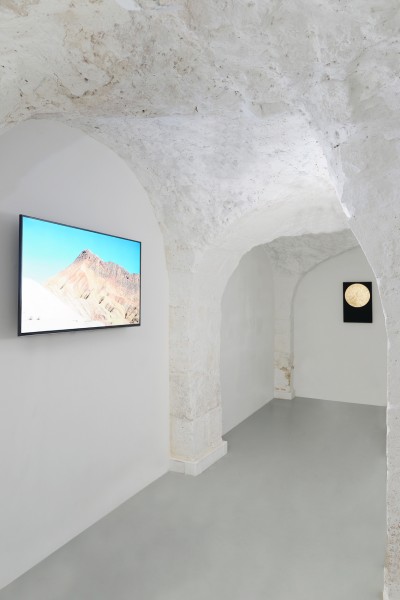
Louis-Cyprien Rials, Voyage en Chine – Is French copy better than Chinese Original ? (vidéo), 2016, 4 K video, format 16 : 9, color, sound, 9’, edition of 5 + 2 AP
Pantokrator, 2016, tilia wood, levka, pigments, gold leaves, serie, 60 x 40 cm, unique piece. Photo © Aurélien Mole

Louis-Cyprien Rials, Reliques (Iraq), 2016, religious artefact found in Baqofah, nearby the Islamic State, Iraq 2015, anti reflective glass, white laquered mapple wood frame, 47,7 x 38 cm, unique piece

Louis-Cyprien Rials, Voyage en Chine – Is French copy better than Chinese Original ? montagne 1 & 2, 2016, reconstituted stone, coloured nail polish, variable dimensions, 2 unique pieces.
Photo © Aurélien Mole

Louis-Cyprien Rials, Honeycomb, 2016, stone and gold leaves, variable dimensions, 3 unique pieces

Louis-Cyprien Rials, Polygon, 2016, 4 K video, format 16 : 9, color, sound, 12’, edition of 5 + 2 AP. Photo © Aurélien Mole

Louis-Cyprien Rials, Polygon, 2016, 4 K video, format 16 : 9, color, sound, 12’, edition of 5 + 2 AP. Photo © Aurélien Mole

Louis-Cyprien Rials, Polygon, 2016, 4 K video, format 16 : 9, color, sound, 12’, edition of 5 + 2 AP. Photo © Aurélien Mole

Louis-Cyprien Rials, Polygon, 2016, 4 K video, format 16 : 9, color, sound, 12’, edition of 5 + 2 AP. Photo © Aurélien Mole
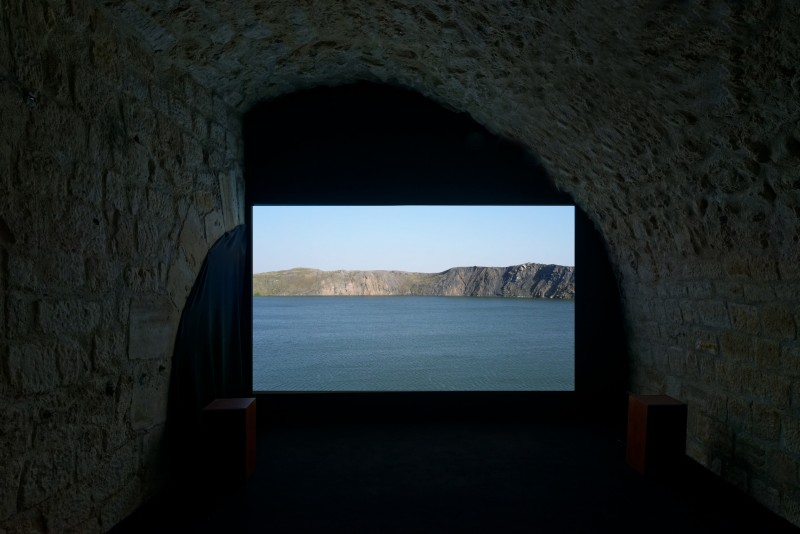
Louis-Cyprien Rials, And there was no miraculous, 2016, 4 K video of a performance, format 16 : 9, color, sound, 3’, edition of 5 + 2 AP
Photo © Aurélien Mole

Louis-Cyprien Rials, And there was no miraculous, 2016, 4 K video of a performance, format 16 : 9, color, sound, 3’, edition of 5 + 2 AP
Photo © Aurélien Mole
………………………………………………..
![]()
73-75 rue Quincampoix 75003 Paris France
Tuesday – Saturday 11 am – 1 pm // 2 pm – 7 pm
tel : +33 (0)1 42 77 05 97
www.galeriedohyanglee.com
![]()
![]()
![]()
………………………………………………..
